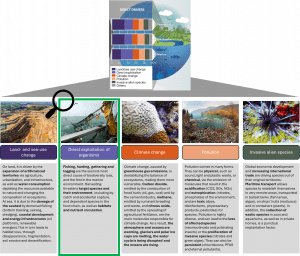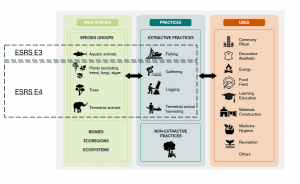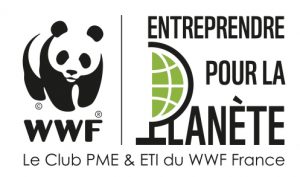Focus on the second anthropogenic pressure on biodiversity: the exploitation of wild species
Definition: Overexploitation and exploitation of wild species
The use of wild species is the subject of a specific IPBES thematic report (IPBES, 2022). This use is sustainable if it corresponds to « the use of components of biological diversity in a way and at a rate that does not lead to the long-term decline of biodiversity, thereby maintaining its potential to meet the needs and aspirations of present and future generations » (CBD, 1992). Otherwise, unsustainable exploitation is the second most direct cause of biodiversity loss, and the leading cause for marine biodiversity (IPBES, 2019).

This exploitation corresponds to the extractive use of living organisms. It includes marine and freshwater fishing, hunting of terrestrial animals, gathering of immobile organisms (flowers, plants, mushrooms, algae) and logging. The exploitation of wild species includes lethal exploitation such as cod fishing or tree felling, but also non-lethal exploitation such as the collection of wild fish for aquariums or the picking of fruit and flowers. It excludes the use of domestic animals (livestock, aquaculture, pets) and the exploitation of non-living materials (hydrocarbons, water, sand, metals). The latter has an impact on biodiversity that is distinct from the exploitation of wild species (see Box below).
|
Box. The impact of (over)exploiting non-living things Water consumption by human populations can deprive ecosystems of water and have an impact on biodiversity. For example, when water is used in ways that make it unavailable to ecosystems: loss of wetlands and river flows, drying up of the landscape, detour of waterways, disappearance of water bodies, this leads to a loss of biodiversity linked to a change in the ecosystem. This involves a land use change, with soils becoming more water-poor, thereby altering the living conditions of the species present. The exploitation of mineral materials (sand, rock, metals) or fossil fuels (oil, gas, coal) does not correspond to the « exploitation of wild species » pressure either. The impacts of this extraction can be very significant for biodiversity, but it corresponds to other pressures: land use change (deforestation, sand extraction), climate change (energy exploitation and hydrocarbon combustion) and pollution (physical pollution and emissions of pollutants such as heavy metals). |
Human activities concerned by the exploitation of wild species
FISHING The main activity linked to the exploitation of wild species is fishing. In 2020, 90.3 million tonnes of aquatic animals were caught (FAO, 2022). Most of these catches were marine fish, but freshwater fish, crustaceans, molluscs and, to a lesser extent, cetaceans were also taken. Of these catches, 82.5% come from sustainable stocks, while 35.4% of the world’s stocks are overexploited (FAO, 2022).
LOGGING Among land-based activities, the production of wood for construction, furniture, energy, paper and cardboard involves the exploitation of wild species. This exploitation has the particularity of affecting organisms that are also habitats for other species. Indeed, the plant cover determines the nature of the ecosystem (desert, prairie, savannah, forest, etc.) as well as being composed of particular species. 12% of trees are directly threatened by overexploitation, which endangers the species that depend on them (IPBES, 2022).
GATHERING Harvesting of plants, algae and mushrooms is linked to food production (porcini, truffles, samphire), cosmetics and pharmaceuticals (arnica, nettle, chamomile). It may seem marginal, but it represents the largest share of wild species exploitation, with 25,100 species collected (IPBES, 2022). When unsustainable, it leads to the rarefaction of wild populations (see arnica replanting initiatives in the Vosges mountains).
HUNTING Finally, land animals may be hunted for food, cultural and educational development or leisure. Excessive hunting can lead to the total disappearance of a species, as demonstrated by the hunting of the Great Auk (Pinguinus impennis) for its meat and feathers, the last individual of which was killed in Iceland in 1844.

Figure taken from the Summary for Policy-Makers of the IPBES report on the Sustainable Use of Wild Species. The impacts and dependencies respectively linked to ESRS E3 and E4 are highlighted.
CSRD and the sustainable use of wild species
Dual materiality analysis is the starting point for the CSRD. It involves identifying sustainability issues, both in terms of dependencies (financial materiality) and impacts (impact materiality). The sustainable exploitation of wild species is the issue where dependencies and impacts come together directly. Sustainably exploited resources (impact materiality) ensure the company’s security of supply; conversely, over-exploited resources jeopardize supply. So, from the view of wildlife exploitation, impacts and dependencies are one and the same.
While any harvesting of wild species constitutes an impact on biodiversity, this can be greatly reduced when harvesting is sustainable. Although the notion of sustainability in wildlife harvesting may differ according to context and authors, it is possible to reduce the risk and associated impact on biodiversity. Thus, in the CSRD, two reporting standards (ESRS – European Sustainability Reporting Standard) are concerned with the exploitation of wild species:
- ESRS E4 standard on biodiversity and ecosystems requires the assessment of materiality linked to the direct exploitation of organisms (AR 4.a.iii). This concerns companies using wood-based products (architecture, furniture, paper, cardboard), as well as those sourcing wild raw materials for food, cosmetics and pharmaceuticals.
- ESRS E3 standard on water and marine resources requires the assessment of materiality linked to the exploitation of fish and seafood (AR 12.a), and thus concerns the entire seafood sector (fishing and aquaculture).
Thus, it is imperative to address this cause of biodiversity collapse and this source of dependence of human activities within the framework of CSRD.
Quantitative assessment of this impact on biodiversity
It is possible to quantitatively assess the impact of the exploitation of wild species.
- FISHERIES For fisheries, the « Biotic Resource Depletion » method (Hélias et al., 2023; Stanford-Clark et al., 2024) makes it possible to quantify the impact in a similar way to other pressures on biodiversity (climate, pollution, land use) via a common unit, the PDF.year.
- FOREST This exploitation is similar to land use. IPBES describes the guarantees of sustainability of this exploitation, notably through certification programs (PEFC, FSC), the preservation of exclusively protected areas and consultation with local populations (IPBES, 2022).
- HUNTING and GATHERING For hunting and gathering, semi-quantitative methods are possible for this major issue in the cosmetics, perfume and pharmaceutical industries.
Sayari’s experience
At Sayari, we take a holistic approach to the impact of human activities on biodiversity. We address the 5 pressures identified by IPBES: land and sea use change, wildlife exploitation, climate change, pollution and invasive species. We deal with impacts on the different biota: terrestrial, freshwater and marine. Finally, these assessments are carried out across the entire value chain. Take a look at our offer on this subject.
For example, we address the pressure of wildlife exploitation in addition to that of land and sea use change, climate change, pollution and invasive species. In several projects, we have applied the biotic resource depletion method for fisheries (Gaillet et al., 2023; Wermeille et al., 2024) and we are applying the PBF method (Asselin et al., 2019), supplementing it with pressure from timber exploitation.
We can support you in studying the impact of your biobased products by including this pressure, and in your implementation of CSRD on ESRS E3 and E4.
Please do not hesitate to contact us.
References
Asselin, A., Rabaud, S., Catalan, C., Leveque, B., L’Haridon, J., Martz, P., & Neveux, G. (2019). Product Biodiversity Footprint – A novel approach to compare the impact of products on biodiversity combining Life Cycle Assessment and Ecology. Journal of Cleaner Production, 248, 119262. https://doi.org/10.1016/j.jclepro.2019.119262
CBD. (1992). Convention on Biological Diversity. In.
FAO. (2022). The State of World Fisheries and Aquaculture 2022: Towards Blue Transformation. FAO.
Gaillet, G., Asselin, A., & Wermeille, A. (2023). Affichage environnemental et produits de la mer. La librairie ADEME. https://librairie.ademe.fr/consommer-autrement/6705-affichage-environnemental-gt-mer.html
Hélias, A., Stanford-Clark, C., & Bach, V. (2023). A new impact pathway towards ecosystem quality in life cycle assessment: characterisation factors for fisheries. The International Journal of Life Cycle Assessment. https://doi.org/10.1007/s11367-023-02136-2
IPBES. (2019). Global assessment report on biodiversity and ecosystem services of the Intergovernmental Science-Policy Platform on Biodiversity and Ecosystem Services, Brondízio, E. S., Settele, J., Díaz, S., Ngo, H. T. (eds). . Zenodo. https://zenodo.org/record/6417333
IPBES. (2022). Thematic assessment of the sustainable use of wild species of the Intergovernmental Science-Policy Platform on Biodiversity and Ecosystem Services.
Stanford-Clark, C., Loiseau, E., & Hélias, A. (2024). Fisheries Impact Pathway: Making Global and Regionalised Impacts on Marine Ecosystem Quality Accessible in Life Cycle Impact Assessment [Article]. Sustainability, 16(9), 3870. https://doi.org/10.3390/su16093870
Wermeille, A., Gaillet, G., & Asselin, A.-C. (2024). Don’t miss the big fish! Operational accounting of two major drivers of marine biodiversity loss in LCA of seafood products. Journal of Cleaner Production, 435, 140245. https://doi.org/10.1016/j.jclepro.2023.140245
We offer solutions adapted to your ambitions
and resources
Would you like to find out about our latest studies or discover our new projects? Follow us on LinkedIn
![]() Member of the European PEF (Product Environmental Footprint) Technical Advisory Board
Member of the European PEF (Product Environmental Footprint) Technical Advisory Board
![]() Member of the French ADEME environmental labelling working group
Member of the French ADEME environmental labelling working group


